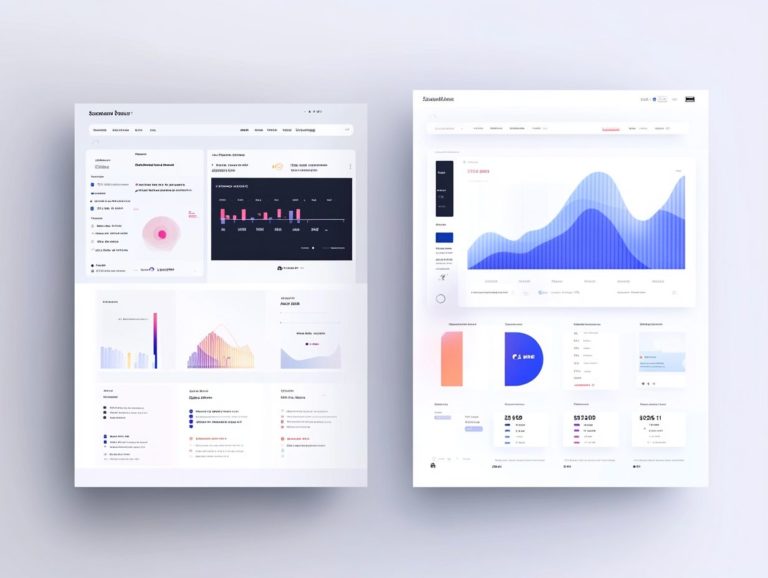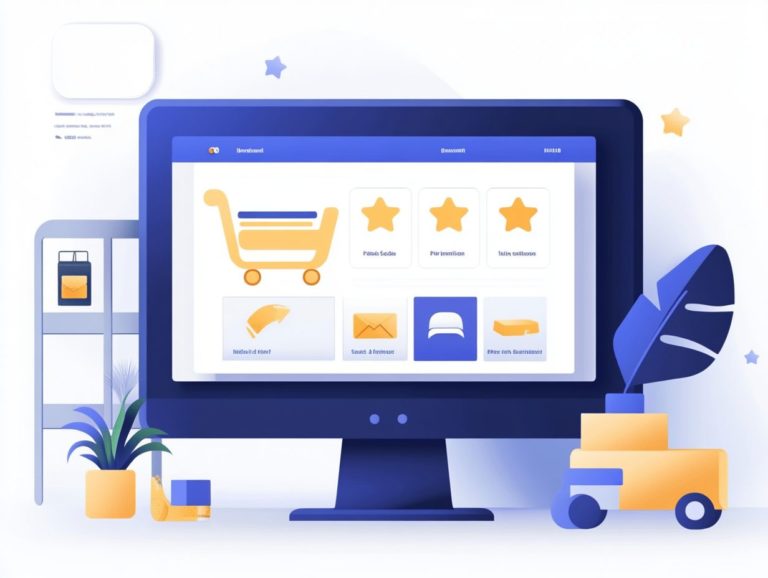How to Use Analytics Tools for Conversion Insights
In today s data-driven landscape, analytics tools are indispensable for businesses aiming to elevate their online performance.
By understanding user behavior and meticulously tracking key metrics, you can significantly enhance conversion rates, leading to a remarkable boost in revenue.
This article delves into the myriad benefits of analytics tools, ranging from web and social media analytics to insightful guidance on selecting the right tool tailored to your specific needs.
You ll gain valuable insights into setting up your tools. You will learn how to analyze data effectively and interpret results, all of which will empower you to implement meaningful changes in your strategy.
Ready to unleash the power of analytics? Let s dive in and discover!
Contents
- Key Takeaways:
- Benefits of Using Analytics Tools
- Types of Analytics Tools
- How to Choose the Right Analytics Tool
- Using Analytics Tools to Unlock Powerful Insights
- Frequently Asked Questions
- What are analytics tools for conversion insights and why are they important?
- How do I choose the right analytics tool for my business?
- What types of data can I gather from using analytics tools for conversion insights?
- Can I use analytics tools for conversion insights to improve my website’s design and user experience?
- Do I need technical skills to use analytics tools for conversion insights?
- How can I use data from analytics tools for conversion insights to increase my website’s conversion rates?
Key Takeaways:

- Use analytics tools to boost your conversion rates and understand user behavior.
- Explore various analytics tools for deep insights into your audience.
- When selecting an analytics tool, weigh factors like cost, features, and compatibility.
What Are Analytics Tools?
Analytics tools are your essential software companions, allowing you to track, analyze, and optimize your online marketing efforts.
By collecting and interpreting data on user behavior, website performance, and conversion rates, these tools provide insights that are vital for enhancing user experience and maximizing your return on investment (ROI).
With options like Google Analytics and various heat mapping tools at your disposal, you can gain a deeper understanding of your traffic sources and refine your strategies accordingly.
By leveraging these analytics platforms, you gain access to both qualitative data like user feedback and session recordings and quantitative analytics that unveil traffic patterns and engagement metrics. For instance, Google Analytics enables you to monitor visitor demographics and behavior flow, key elements in identifying trends and discovering what content truly resonates with your audience.
Heat maps show how users interact with your page, shedding light on the areas of a webpage that attract the most attention.
Together, these optimization tools enable you to make informed decisions, enhancing your website’s performance and ultimately driving higher conversion rates.
Benefits of Using Analytics Tools
The benefits of utilizing analytics tools are both extensive and vital for your business as you work to enhance your online presence and effectively drive traffic.
These tools deliver practical tips that can significantly elevate your conversion rates and enrich your overall marketing intelligence.
By leveraging robust analytics solutions, you can design more effective customer journeys and refine your lead capture mechanisms, ultimately transforming your website into a powerful conversion engine.
Improving Conversion Rates
Improving conversion rates is a top priority for you as a digital marketer, and leveraging analytics tools along with understanding how to use surveys for conversion insights will give you the insights you need to hit that target.
With effective strategies like A/B testing a method where you compare two versions of something to see which performs better and optimized landing page design, you can refine your approach.
By diving deep into user interactions and behaviors, you can fine-tune your lead generation tactics and elevate your email marketing campaigns, ultimately driving more conversions.
Through these methods, you can pinpoint which elements resonate best with your audience, allowing for more tailored messaging and enriched user experiences.
A/B testing makes it easy to compare different versions of emails or landing pages, helping you identify what truly captures attention and inspires action. Thoughtful landing page design that meets user expectations can significantly reduce bounce rates.
By harnessing user behavior data, you can craft compelling calls-to-action and create personalized experiences that boost overall engagement and satisfaction, resulting in higher conversion rates.
Tracking User Behavior
Tracking user behavior is essential for understanding how visitors engage with your online content. Utilizing tools like session replay (which allows you to watch how users navigate your site) and click tracking can uncover valuable insights into user preferences and pain points. Implementing feedback tools and conducting user testing helps you gather qualitative data that directly informs your optimization strategies.
This data provides a clear overview of user journeys, revealing common navigation paths and pinpointing bottlenecks that may hinder conversions. By leveraging heatmaps, surveys, and A/B testing (which compares two versions of a webpage), you can monitor real-time interactions and refine your website based on user feedback, ensuring a more intuitive experience.
Analyzing metrics such as bounce rates and dwell times helps you tailor content that resonates with your visitors, ultimately enhancing engagement. This holistic approach to user behavior analysis plays a significant role in driving higher traffic and conversion rates for your business.
Types of Analytics Tools

Explore a variety of analytics tools ready to boost your marketing strategy! Each tool is tailored to meet distinct marketing needs and objectives.
From web analytics tools that assess your website’s performance to social media analytics tools that provide insights into engagement metrics, these resources are essential.
These tools elevate your marketing intelligence and enable you to make data-informed decisions that can significantly impact your strategy.
Web Analytics Tools
Web analytics tools are specialized software applications designed to track and analyze user behavior on websites. Google Analytics is one of the most popular platforms due to its comprehensive features for monitoring traffic sources and user interactions. By utilizing heat mapping technology, you can gain a clearer understanding of user behavior, as it visually represents how visitors engage with various elements on your webpage.
Integrating these tools unlocks deeper insights into user interactions, such as bounce rates, session durations, and conversion pathways. With this valuable data, you can tweak your content to better meet user needs! Google Analytics offers detailed reports that illuminate trends and demographics, giving you the tools to refine your strategies effectively. Meanwhile, heat maps highlight where users click most frequently, revealing which areas capture attention and which may require enhancement.
Together, these functionalities equip you with a powerful toolkit for improving website performance and engaging users in a more impactful way.
Social Media Analytics Tools
Social media analytics tools are essential for businesses looking to gauge their online presence and engagement across various platforms. These tools provide invaluable marketing intelligence, helping you understand customer insights and traffic sources. By diving into social media metrics, you can refine your strategies to forge stronger connections with your audience and enhance the effectiveness of your campaigns.
These tools present a holistic view of key performance indicators such as engagement rates, follower growth, and post reach. They illuminate the behaviors and preferences of your target demographic, giving you a clearer picture of what resonates with them. Understanding these metrics allows you to identify which types of content hit the mark, enabling you to tailor your messaging with precision.
Tracking sentiment analysis reveals how your audiences respond to your campaigns, providing the opportunity to adjust your tactics in real time. Ultimately, leveraging these insights cultivates a more data-driven approach, ensuring your marketing efforts align seamlessly with consumer interests while delivering a higher return on investment.
How to Choose the Right Analytics Tool
Selecting the right analytics tool is essential for businesses looking to refine their marketing strategies. Consider a range of factors to ensure that the chosen tool aligns perfectly with your unique marketing needs and objectives.
Resources like an ROI calculator or website grader can be invaluable in this process, helping you assess the effectiveness and appropriateness of various analytics solutions.
Factors to Consider
When selecting analytics tools, consider these key factors:
- User experience
- Data visualization capabilities
- Effectiveness in extracting customer insights
- Ease of use
- Pricing models
- Real-time reporting
- Customizable dashboards
- Seamless integration with existing systems
A well-rounded analytics tool should not only deliver robust data but also present it in a way that is easy to interpret and act upon, allowing you to make informed decisions.
Ease of use is paramount; a user-friendly interface enables your team to quickly glean actionable insights without wading through a steep learning curve. It’s also essential to evaluate pricing models closely, as they can vary widely and significantly impact your budget constraints and return on investment.
Features like real-time reporting and customizable dashboards enhance usability, allowing you to tailor the experience to meet your specific needs. Seamless integration with existing systems streamlines workflows, reducing friction in data management.
Choosing the right analytics tool depends on a complete understanding of these factors, enabling your team to drive meaningful actions based on insightful data.
Using Analytics Tools to Unlock Powerful Insights

Utilizing analytics tools to uncover conversion insights requires a methodical approach. Ensure that your data is carefully organized and analyzed, allowing you to extract actionable conclusions that can elevate your marketing strategies, especially by learning how to use analytics to improve conversion rates.
By interpreting the results effectively, you can make informed adjustments to optimize your conversion funnels and significantly enhance overall performance.
Setting Up and Analyzing Data
Setting up and analyzing data within analytics tools demands meticulous planning and execution on your part. Ensure that all relevant metrics are tracked and effectively visualized for thorough analysis.
Begin by identifying key performance indicators (KPIs), which are important metrics that measure success, that resonate with your overall business goals. Next, select an appropriate analytics tool that offers advanced tracking features tailored to your needs. For a deeper understanding of this process, learn how to use analytics for affiliate marketing growth. Once you lay this foundation, ensure that conversion tracking is implemented correctly, concentrating on the user interactions that matter most to your objectives.
Tagging systems boost both user feedback and page views. As the data starts to accumulate, visualize it through dashboards and reports. This will simplify interpretation, revealing trends and areas for improvement that are crucial for well-considered choices.
Interpreting Results and Making Changes
Interpreting results from analytics tools is essential for making informed changes that elevate your marketing strategies and optimize conversion funnels for enhanced performance. By effectively leveraging data visualization techniques, which turn raw data into easy-to-read visuals, you can uncover trends and identify areas for improvement, leading to actionable insights.
This process involves transforming complex data sets into visual formats, like charts and graphs, which simplify interpretation and facilitate quick comprehension of patterns. When you harness these visual insights, pinpointing specific stages in the conversion funnel that may be underperforming or in need of fine-tuning becomes a breeze.
As you analyze this information, implementing data-driven changes that resonate with your target audience not only becomes easier but also leads to more efficient marketing campaigns and increased conversion rates. Embracing a visualization approach clarifies the journey from visitor to customer and acts as a catalyst for the strategic adjustments that drive your success.
Frequently Asked Questions
What are analytics tools for conversion insights and why are they important?
Analytics tools for conversion insights are software programs that track and analyze data related to website traffic and user behavior. They are important because they help businesses understand how their website is performing and make data-driven decisions for affiliate success to improve conversion rates.
Start analyzing today to boost your success!
How do I choose the right analytics tool for my business?

When choosing an analytics tool for conversion insights, consider your budget and the features you need. Additionally, think about the level of technical skills required to use the tool. Using analytics to improve your conversion rates can be beneficial, and reading reviews while comparing different options can help you make an informed decision.
What types of data can I gather from using analytics tools for conversion insights?
Analytics tools collect a variety of data, including website traffic, click-through rates, and user demographics. Plus, track key actions on your site like form submissions and purchases to seize every opportunity!
Can I use analytics tools for conversion insights to improve my website’s design and user experience?
Absolutely! Analytics tools provide valuable insights into how users interact with your website. By analyzing data like page views and click-through rates, you can identify areas for improvement and make informed decisions to enhance your site’s design and user experience.
Do I need technical skills to use analytics tools for conversion insights?
While some analytics tools may require a certain level of technical skills, many user-friendly options are available that need little to no technical knowledge. These tools often provide dashboards and reports that make it easy to interpret data.
How can I use data from analytics tools for conversion insights to increase my website’s conversion rates?
Regularly monitoring and analyzing data from analytics tools helps you identify patterns and trends that can boost conversion rates. For instance, learning how to use analytics with affiliate programs can provide valuable insights. If you notice a high bounce rate on a specific page, make adjustments to keep users engaged and encourage conversions.






